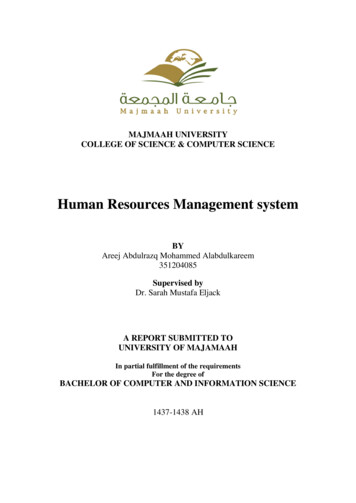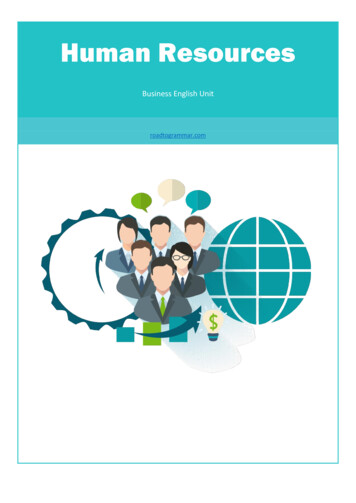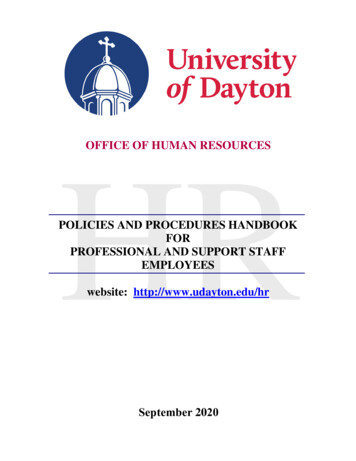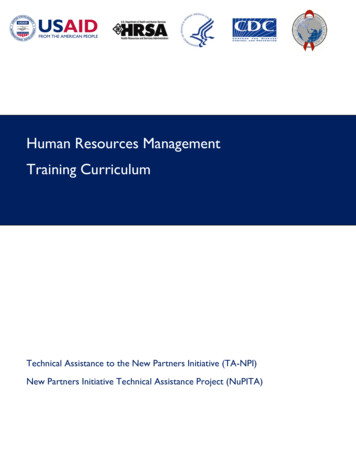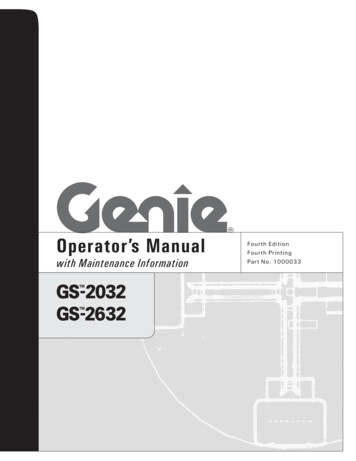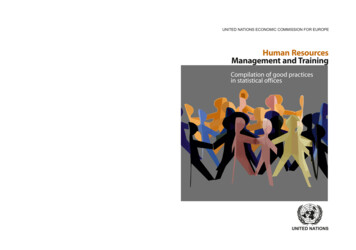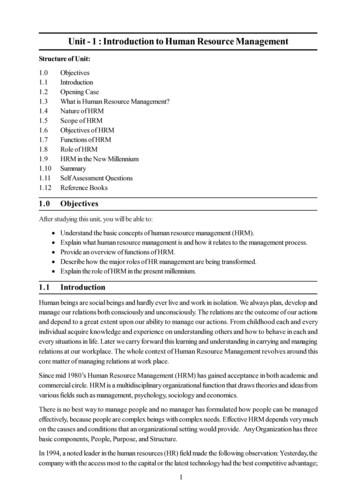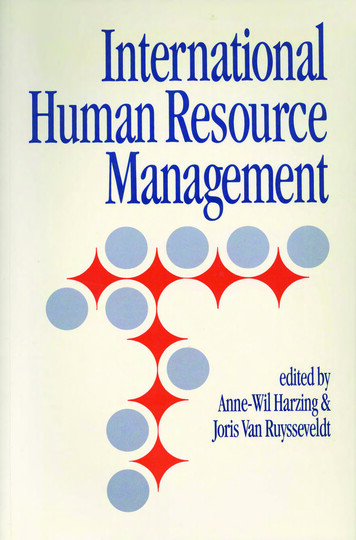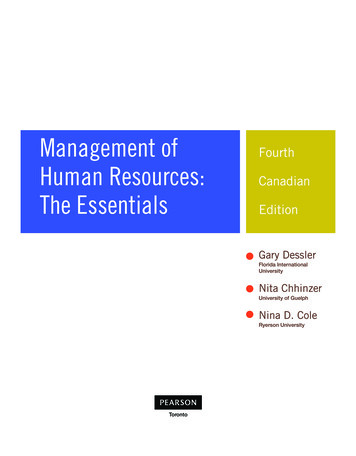
Transcription
Management ofHuman Resources:The Essentials Fourth Canadian EditionGary DesslerFlorida InternationalUniversityNita ChhinzerUniversity of GuelphNina D. ColeRyerson UniversityTorontoA01 DESS4905 04 SE FM.indd 112/31/13 11:46 AM
Acquisitions Editor: Deana SigutMarketing Manager: Leigh-Anne GrahamDevelopmental Editor: Charlotte Morrison-ReedMedia Editor: Imee SalumbidesMedia Producer: Olga AvdyeyevaProgram Manager: Karen TownsendProject Manager: Jessica HellenProduction Services: GEX Publishing ServicesPhoto Permissions Research: Q2a/Bill Smith/ Rebecca O’MalleyText Permissions Research: Samantha Bingenheimer, ElectronicPublishing Services Inc.Cover and Interior Designer: Anthony LeungCover Image: GettyImagesDedicationTo my mother—G.D.I would like to dedicate this book to those studentswho consistently demonstrate the ability to integrate,analyse and transfer knowledge, both within the classroom and outside of it.Your excellence keeps me inspired.—N.N.C.To Peggy Martin—N.D.C.Credits and acknowledgments of material borrowed from other sources and reproduced, with permission, in this textbooka ppear on the appropriate page within the text and on pp. 347–366.Original edition, entitled Human Resource Management, published by Pearson Education, Inc., Upper Saddle River, New Jersey,USA. Copyright 2013, 2011, 2008, 2005, 2003 by Pearson Education, Inc. This edition is authorized for sale only in Canada.If you purchased this book outside the United States or Canada, you should be aware that it has been imported without theapproval of the publisher or author.Copyright 2015, 2011, 2007, 2004 Pearson Canada Inc. All rights reserved. Manufactured in the United States of America.This publication is protected by copyright and permission should be obtained from the publisher prior to any prohibited reproduction, storage in a retrieval system, or transmission in any form or by any means, electronic, m echanical, p hotocopying,recording, or likewise. To obtain permission(s) to use material from this work, please submit a written request to PearsonCanada Inc., Permissions Department, 26 Prince Andrew Place, Don Mills, Ontario, M3C 2T8, or fax your request to416-447-3126, or submit a request to Permissions Requests at www.pearsoncanada.ca.10 9 8 7 6 5 4 3 2 1 [TBC]Library and Archives Canada Cataloguing in PublicationDessler, Gary, 1942-, authorManagement of human resources: the essentials / Gary Dessler,Florida International University, Nita Chhinzer, University of Guelph,Nina D. Cole, Ryerson University. -- Fourth Canadian edition.Revision of: Management of human resources / Gary Dessler, CarolinRekar Munro, Nina D. Cole. -- 3rd Canadian ed. -- Toronto:Pearson Prentice Hall, 2010.Includes bibliographical references and index.ISBN 978-0-13-211490-5 (pbk.)1. Personnel management--Textbooks. 2. Personnel management-Canada--Textbooks. I. Cole, Nina D. (Nina Dawn), author II. Chhinzer, Nita, author III. Title.HF5549.M3132 2014658.3C2013-908455-XISBN 978-0-13-211490-5A01 DESS4905 04 SE FM.indd 212/31/13 11:46 AM
Brief ContentsPreface ixPart 1Human Resources Management in Perspective 1Chapter 1 The Strategic Role of Human Resources Management1Chapter 2 The Changing Legal Emphasis: Compliance and Impact on CanadianWorkplaces 23Part 2Meeting Human Resources Requirements 48Chapter 3Designing and Analyzing Jobs48Chapter 4 Human Resources Planning and RecruitmentChapter 5 SelectionPart 375114Developing Effective Human Resources 144Chapter 6Orientation and Training144Chapter 7 Performance Management 171Part 4Total Rewards 198Chapter 8Strategic Pay Plans 198Chapter 9 Employee Benefits and Services231Part 5 Building Effective Employee–Employer Relationships 257Chapter 10Occupational Health and Safety257Chapter 11 Managing Employee Separations: Foundations of Employee Engagement,Communication, and Turnover Management 285Chapter 12 Labour RelationsPart 6303Global Issues in Human Resources Management 327Chapter 13 Managing Human Resources in a Global BusinessNotes347Glossary000Name and Organization IndexSubject IndexCredits327000000000iiiA01 DESS4905 04 SE FM.indd 312/31/13 11:46 AM
A01 DESS4905 04 SE FM.indd 412/31/13 11:46 AM
Table of ContentsPreface ixPart OneHuman Resources Management in Perspective 1Chapter 1 The Strategic Role of Human Resources Management 1The Strategic Role of Human Resources Management 2A Brief History of HRM 3Strategic HR The HR Role Continues to Evolve 8Growing Professionalism in HRM 9Environmental Influences on HRM 12Chapter 2 The Changing Legal Emphasis: Compliance and Impact on CanadianWorkplaces 23The Legal Framework for Employment Law in Canada 24Legislation Protecting the General Population 27Global HRM UK Court Awards 1.7 Million to Bullied Employee 34Legislation Specific to the Workplace 39Part TWOMeeting Human Resources Requirements 48Chapter 3 Designing and Analyzing Jobs 48Fundamentals of Job Analysis 49Step 1: Review Relevant Organizational Information 51Step 2: Select Jobs to Be Analyzed 54Step 3: Collecting Job Analysis Information 59Step 4: Verifying Information 64Step 5: Writing Job Descriptions and Job Specifications 65Entrepreneurs and HR A Practical Approach to Job Analysis and Job Descriptions 67Step 6: Communication and Preparations for Revisions 71Chapter 4 Human Resources Planning and Recruitment 75The Strategic Importance of Human Resources Planning 76Forecasting the Availability of Candidates (Supply) 79Entrepreneurs and HR Succession Planning and Family Businesses 82Strategic HR Pumping Up People Supply 83Forecasting Future Human Resources Needs (Demand) 84Planning and Implementing HR Programs to Balance Supply and Demand 88Recruitment 93The Recruitment Process 94Developing and Using Application Forms 95Recruiting from within the Organization 96Recruiting from Outside the Organization 98vA01 DESS4905 04 SE FM.indd 512/31/13 11:46 AM
viContentsRecruiting a More Diverse Workforce 107Strategic HR Attracting the Younger Generation 108Workforce Diversity The Disconnect in Recruiting People with Disabilities 109Chapter 5 Selection 114The Strategic Importance of Employee Selection 115Workforce Diversity Principles for Assessment Accommodations 119Step 1: Preliminary Applicant Screening 119Step 2: Selection Testing 120Step 3: The Selection Interview 128Step 4: Background Investigation/Reference Checking 134Step 5: Supervisory Interview and Realistic Job Preview 136Step 6: Hiring Decision and Candidate Notification 137Appendix 5.1 A Guide to Screening and Selection in Employment 141PART THREEDeveloping Effective Human Resources 144Chapter 6 Orientation and Training 144Become a Learning Organization 145Orienting Employees 146Strategic HR Onboarding: The First Step in Motivation and Retention 147The Training Process 152The Five-Step Training Process 154Career Planning and Development 161Workforce Diversity Career Development for Older Workers 162Managing Internal Employee Movement 166Chapter 7 Performance Management 171The Strategic Importance of Performance Management 172The Performance Management Process 172Step 1: Defining Performance Expectations 173Global HRM Performance Appraisal Criteria in China 174Step 2: Providing Ongoing Coaching and Feedback 175Step 3: Performance Appraisal and Evaluation Discussion 175Step 4: Determine Performance Rewards/Consequences 180Step 5: Career Development Discussion 181Performance Appraisal Problems and Solutions 181Workforce Diversity Watch for Cultural Biases in Assessing Employees 184Strategic HR Jaguar Land Rover Formal Appraisal Discussion Training 191Legal and Ethical Issues in Performance Management 193The Future of Performance Management 194A01 DESS4905 04 SE FM.indd 612/31/13 11:46 AM
viiContentsPART FOURTotal Rewards 198Chapter 8 Strategic Pay Plans 198The Strategic Importance of Total Employment Rewards 199Strategic HR Rewards Program Effectiveness at the World’s Most Admired Companies 200Basic Considerations in Determining Pay Rates 201Pay Equity 202Establishing Pay Rates 203Pay for Knowledge 212Developing Effective Incentive Plans 213Money and Motivation 215Types of Incentive Plans 216Strategic HR Rewards That Work 217Organization-Wide Incentive Plans 225Chapter 9 Employee Benefits and Services 231The Strategic Role of Employee Benefits 232Government-Mandated Benefits 233Voluntary Employer-Sponsored Benefits 238Global HRM Defined Benefit Pension Problems and Solutions around the World 246Employee Services 248Flexible Benefits Programs 252Benefits Administration 253Part FIVEBuilding Effective Employee–Employer Relationships 257Chapter 10 Occupational Health and Safety 257Strategic Importance of Occupational Health and Safety 258Basic Facts about Occupational Health and Safety Legislation 258What Causes Accidents? 262Workforce Diversity Guiding Young Workers in Health and Safety 267How to Prevent Accidents 267Strategic HR Top Management Commitment to Safety at Steelcase Canada Pays Off 269Entrepreneurs and HR Small Business Safety Calculator 270Occupational Health and Safety Challenges in Canada 271Employee Wellness Programs 281A01 DESS4905 04 SE FM.indd 712/31/13 11:46 AM
viiiContentsChapter 11 Managing Employee Separations: Foundations of Employee Engagement,Communication, and Turnover Management 285The Importance of Managing Employee Separations 286Managing Turnover 286Employee Engagement and Fairness in Employee Separations 296Chapter 12 Labour Relations 303Introduction to Labour Relations 304Workforce Diversity Collective Agreement Puts Aboriginals First 306Strategic HR UFCW Forms a “Super Local” 307The Labour Relations Process 308Strategic HR NHL Lockout Timeline (2012–2013 season) 319The Impact of Unionization on HRM 324PART SIXGlobal Issues in Human Resources Management 327Chapter 13 Managing Human Resources in a Global Business 327The Globalization of Business and Strategic HR 328How Intercountry Differences Affect HRM 328Workforce Diversity Mummy Crew in Monster Trucks 329Global Relocation 331Considerations in Global HRM 334Repatriation 338Managing Global Workers within Canada 339Global HRM Successful Integration of Immigrants in Canada 343Notes 347Glossary 000Name and Organization Index 000Subject Index 000Credits 000A01 DESS4905 04 SE FM.indd 812/31/13 11:46 AM
PrefaceManagement of Human Resources: The Essentials, Fourth Canadian Edition,brings both human resources and non–human resources students into the current and comprehensive discussion on the ways in which human resources areamong the most important assets in organizations today. Human resources refersto the employees in a company, more specifically, the knowledge, skills, assets,and competencies they bring to work to help the organization achieve its objectives. These resources continue to provide a source of competitive advantage fororganizations in a hyper-competitive, global environment.The strategic importance of human resources management (HRM) activitiesis emphasized throughout the book, using recent examples from the Canadianemployment landscape. Knowledge of HRM is important for supervisors andmanagers in every field and for employees at every level—not just those workingin HR departments or aspiring to do so in the future.The Canadian fourth edition provides extensive coverage of all HRM topics,such as job analysis, HR planning, recruitment, selection, orientation and training, career development, compensation and benefits, performance appraisal,health and safety, and labour relations. Practical applications are highlightedwith Tips for the Front Line and Hints to Ensure Legal Compliance icons inthe margins. Research Insights are also highlighted, and Ethical Dilemmas arepresented for discussion.KEY FEATURES OF THE CANADIANFOURTH E DITIONComprehensive Introductory Chapter. The first chapter provides a c omprehensiveoverview of the strategic importance of HR, highlighting the evolution ofHR over the years, the advances in measuring HRM’s contribution to thebottom line, and HRM’s critical role in strategy implementation.Legal Emphasis. Chapter 2 provides a clear understanding of the often overlapping areas of legislation that affect the employment relationship. This includesa discussion of key legal cases, potential outcomes and remedies to violations,as well as a discussion about employer rights related to employment.Significant Discussion of Managing Decline. Chapter 11 focuses on the impactand management of turnover (quits, layoffs, termination, etc.). This includesa focus on legal, psychological, and communication issues.More Coverage on the Impact of Globalization on HR. Further discussion on theimpact of globalization on HR was added throughout with a focus on bothCanadian organizations’ interactions on a global scale and the impact ofimmigrants on the Canadian labour force. Specific sections, such as performance management (in addition to performance appraisal), the impact ofimmigration on the labour force, and employability skills, are introduced.Integrated Chapters. Rather than approaching topics as isolated silos, the bookhighlights areas of overlap in order to present HRM as an integrated setof topics.ixA01 DESS4905 04 SE FM.indd 912/31/13 11:46 AM
x 202PrefacePart 4 Total Rewardstheir employees. Further, these laws are constantly changing and requirecontinual monitoring to ensure compliance. Employment Standards Acts andHuman Rights Acts must also be taken into consideration, as discussed inChapter 2. Pay equity is a major compensation issue and stems from the perceptions of equity discussion above. In addition, workers’ compensation lawsalso apply.Required Professional Capabilities (RPCs). The required professional capabilitiesto be discussed are listed at the beginning of each chapter and indicated inthe margins throughout the text. These RPCs are set out by the CanadianPAY EQUITYThe purpose of pay equity legislation is to redress systemic gender discriminationCouncil of Human Resources Associations for students preparing to writein compensation for work performed by employees in female-dominated jobclasses. Pay equity requires that equal wages be paid for jobs of equal value orNationalKnowledgeExam.“worth” to the employer, as determined bythegender-neutral(i.e., free of anybiasbased on gender) job evaluation techniques. Althoughsuch factorsas differencesin hoursworked, experience This new element added in multiple places throughout eachHRby theNumbers.Have We Achieved Pay levels, education levels, and level of unionization contribEquity Yet?ute to the wage gap,chaptersystemic discriminationis also presfocuseson the impact of HR practices and policies. The format ofEstimated per-womanent.The HR by the Numbers box highlights the impact 0.7–2 m lifetime-differenceof using different perspectives to identify how meaningthese sections is more magazine style and visually enticing for the students.financial loss (depending on education) due to payful differences in pay can be overall.pay equity Providing equal pay tomale-dominated job classes andfemale-dominated job classes ofequal value to the employer.HR by the Numbersinequities8Instances of pay inequity continue to occur, even inlarge, structured organizations. Several internal assessments of pay equity at the University of British Columbiaestablished that on average, compensation of full-timefemale professors was 14 000 less than that of theirmale counterparts. After adjusting for confounding factors (such as specialization, tenure, etc.), a 3 000 gapin pay still existed. As a result, in 2013, the universityCanada’s rank among Organizationgave all 880 tenure-tracked and tenured female facultyfor Economic Co-operation andmembers a 2 percent increase in base salary in order toDevelopment (OECD) countriesachieve pay equity. The increase was made retroactive toJanuary 1, 2010 at a cost of 2 million to the university. A similar situation occurred at Western UniversityYoung women graduating fromin 2006, resulting in individual adjustments to femaleuniversity earn less than malefaculty members’ salaries to compensate for the 2 200graduatespost-confounding factor difference in pay between menand women. These cases highlight how the struggle forincome parity between genders is far from over, and aCents women earn for each dollar achallenge in even the most structured organizations.9man earns in OntarioIn addition, each jurisdiction has its own workers’compensation laws. The objective of these laws is to proYoung women graduating fromvide a prompt, sure, and reasonable income to victimshigh school earn less than maleof work-related accidents and illnesses. The Employmenthigh school graduatesInsurance Act is aimed at protecting Canadian workersfrom total economic destitution in the event of employment termination that is beyond their control. Employersand employees both contribute to the benefits providedAssociation of Workers’by this act. This act also provides up to 45 weeks of compensation for workersCompensation Boards of Canadaunemployed through no fault of their own (dependingon the119unemploymentwww.awcbc.orgChapter 5 SelectionSept. 1771 percent of the waythrough the calendar year,marking the day women in Canada start workingfor free, according to the Equal Pay Coalition17th16%7127%Highlighted ThemesWORKFORCE DIVERSITYPrinciples for Assessment Accommodationsqualification “knowledge of the organization’s mandate and its business” is assessed, providing additional time could be inappropriate for a test assessingthe qualification “verify information rapidly andaccurately.” In the latter case, the obtained resultmay not be representative of the applicant’s true ability to do the task rapidly.Principle 4: Base assessment accommodations oncomplete information.To make appropriate decisions when determining assessment accommodations, there is a need torely on complete information on the three elementsmentioned earlier, justifying the case-by-caseapproach.When assessing persons with disabilities, those responsible for assessment should be guided by four principles to determine accommodations:Principle 1: Provide all applicants with an equal opportunity to fully demonstrate their qualifications.A disability may hinder a person from fully demonstrating his or her qualifications using a particularassessment instrument. Therefore, adjustments need tobe made to either the administration procedures or theassessment instrument itself, so that the person is in aposition to fully demonstrate his or her qualifications.Principle 2: Determine assessment accommodations on acase-by-case basis.Source: Guide for Assessing Persons with Disabilities, www.Three key elements must be considered when luation/apwd-eph/mining appropriate accommodations: the nature andChapter 6 Orientation and Training147pdf/apwd-eph-eng.pdf (pp. 10–12), Public Service Commissionthe extent of the individual’s functional limitation, theof Canada, Policy Development Directorate, July 2007.type of assessment instrument being used, and theReproduced with the permission of the Minister of Public Worksnature and level of the qualification being assessed.and Government Services Canada, 2012.canreductionsPrinciple 3: Do not alter the natureorleadleveltoof thequalifica-in turnover, increased morale, fewer instances of correctivediscipline, and fewer employee grievances. It can also reduce the number of worktion being assessed.For example, although providingadditionaltimeplace injuries,particularlyfor young workers.4 The bottom-line implications ofto complete a test could besuccessfulappropriatewhen thecan be dramatic, as described in the Strategic HR box.orientationemployee orientation (onboarding)A procedure for providing newemployees with basic backgroundinformation about the firm andthe job. Workforce Diversity. The Workforce Diversity boxesdescribe some of the issues and challenges involved in managing the diverse workforce found in Canadian organizations.The broad range of types of diversity addressed include generational/age, ethnic, gender, racial, and religious.Purpose of Orientation ProgramsEmployee orientation (onboarding) provides new employees with basic background information about the employer and specific information that they needto perform their APPLICANTjobs satisfactorily. At the SCREENINGLaw Society of Upper Canada, anySTEP 1: PRELIMINARYSTRATEGIC HR peshkova / fotoliaOnboarding: The First Step in Motivation andRetentionMore and more HR professionals are improving the initial screening processwith the use of technology.Professor Jerry Newman is one of the authors of a bestselling book on compensation. He worked undercover asa crew member in seven fast-food restaurants during a14-month period to research total rewards. One of hisfindings was that the onboarding (also known as employeeorientation) process played a significant role in long-termperceptions of management’s leadership abilities and thequality of non-monetary rewards.In the best restaurant he worked for, he walked in andasked a counter worker for an application. She handedit to him, suggested that he fill out the application inA01 DESS4905 04 SE FM.indd 10Initial applicant screening is generally performedby members of the HR department. Applicationforms and résumés are reviewed, and those candidatesthe essentialselectioncriteriathelobby, notand meetingin one simplegesture, createda positiveare impressioneliminatedbyfirst.Then,the remainingfirstasking,“Wouldyou like a applicasoda?”tions areit examinedand thosewhotimesmostAlthoughmay seem trivial,it wascandidatesone of the fewcloselywentmatchthe lengths,remainingjob specificationsareanyoneto anyhoweverminor, to satisfyidentifiedgivenfurther consideration.theneeds of anda futureemployee.Thefirstand weeks ofisemploymentare crucialTheusedaysof technologybecoming increasinglyinpopularthe turnoverreductionprocess as realitybeginstoto helpHR professionalsimprovethe iniconvergewith or process.diverge froman allemployee’sneedsortial screeningAlmostlarge limpressions goesafirmswith highturnoverapplilongway towardfutureview of non-monetarycationsto helpshapingscreen alargenumbersof candidatesrewards.and generate short lists of individuals who willIn recentthe stepfast-foodhasprocess.mademoveon toyears,the nextin theindustryselectionStrategic HR. These boxes provide examples that illustratethe ways in which organizations are using effective HRM policies and practices to achieve their strategic goals. concerted efforts to reduce turnover. Many chains havecut turnover in half during the past five years. Why?Because when they start to analyze costs, the results ofsuccessful onboarding are dramatic.Assume a typical store does 1 million in sales andprofits are 10 percent ( 100 000). A typical turnover,according to most brands, costs between 1 500 and 2 000. If turnover is 150 percent and the typical storehas 40 employees, then 60 employees turn over during the course of the year. Taking the midpoint of thereplacement cost, 60 employees at 1 750 each equals 105 000. With profits at 100 000, the turnovercosts eat up a store’s profitability. This is why fast foodhas made reducing turnover a high priority. And the costof turnover in, say, high-tech industries is much higherthan 1 500 or 2 000. It quickly becomes apparentthat reducing turnover, partially accomplished througha positive and successful onboarding experience, canhave very positive payoffs.Source: Contents 2009. Reprinted with permission fromWorldatWork. Content is licensed for use by purchaser only. Nopart of this article may be reproduced, excerpted or redistributed inany form without express written permission from WorldatWork.Photo: faculty/jmnewman12/31/13 11:46 AM
Preface82Part 2174Part 3xiMeeting Human Resources RequirementsDeveloping Effective Human Resourcesand leaving the organization. These proportions (probabilities) are used to forecasthuman resources supply.performance. Contextual performance reflects an individual’s indirect contribucontextual performance Anindividual’s indirect contributiontion to the organization in terms of improving the organizational, social, andto the organization in terms ofand behaviours that contribute to organizational effectiveness, beyondpsychologicalimproving the organizational,those specified for the job. This includes extra-role behaviours and contextualsocial, and psychologicala sourceof immensestress for infamilybusinessSuccession Planning and FamilyfactorsBusinesseslike “demonstrates a bepositiveattitude”and “pitchesto helpothersbehaviours that contributeowners. Therefore,manyperformancechoose to ignorethe issue 9whenneeded,”whichas ness,the secondquarter of 2010,smallbusinessescre- have surfacedof succession planning altogether.beyondfor the job.Thesegoalsmay beatedthose35 specified549 jobs,while largefirmscreatedonlyinformally known, but not formally defined, which can andrewgenn / fotoliaENTREPRENEURSHR2. Second, a family business is a great source of prideproblematicmanagement. For the legitimacy of the728 jobs. During that period, becomesmall businessesin thein performancefor the business owner and is often their singleperformancesystem to be maintained, employees also need to beconstruction sector alone accountedfor 23 management014 newlargest asset. The concept of retirement or walkingaware andof whichare expected and which are discretionary.jobs, while those in the healthcaresocialbehavioursassisaway can be incomprehensible to those who builtUltimately, the performance management processtance sectors introduced 9 755 new jobs.the business.be separated from performance measurement.Multigenerational family-controlled businesses cannot3. There may not be a qualified or interested successorneed to be developed in aoften struggle with succession planning. Only one-third Performancewithin theexpectationsfamily.of family-owned businesses survive the transition to the legally defensible (correlated with job activities), clear,these aredifficultissues totheydealmustwith, befamilysecond generation. And of these, only one-third survive and Whilemeasurableway.In addition,com5businessesmustbegintotakean informedand stratethe transition to the third generation.municated and supported as suchby the organization.gic approachThere are many reasons for these failures.Alignedwith tothethesesalesissues.associate example, a “personalselling” activity can be measured in terms of how manydollars of sales the associate is to generate personally.“Keeping customers away from executives” can be measured with a standard of no more than 10 customercomplaints per year being the sales associate’s target. In general, employees shouldalways know ahead of time how and on what basis they will be appraised. ItIn the example provided, there were 35 employees in the foreperson occupaTO ENSURE LEGALis important to note that expectations cannot discriminate directly or indirectlytion in 2013. Out of these, 82 percent (28 employees) are expected to remain inCOMPLIANCEagainst anyone on protected grounds (gender, age, disability, and so on).that position next year (based on past levels of activity). The organization canIn global companies, performance appraisal criteria may need to be modianticipate that 8 percent of the foreperson population (which would be 3 out offied to be consistent with cultural norms and values. An interesting studythe 35 employees in 2013) would be promotable to the role of plant manager.found that some criteria are acceptable in many cultures, as discussed in theIn addition, the past trends show that 10 percent of employees at this level areGlobal HRM box.lost to turnover (representing 4 employees who are expected to leave the organization before the start of next year). In addition, out of the 110 team leaders(the level below), 11 percent (12 employees) would be eligible for promotionto a foreperson position. Therefore, next year’s projected supply of forepersonsResearchfoundthree performanceappraisalfactorsPerformance Appraisal CriteriawouldinbeChinathe 28 from this yearwho areprojectedto stay in thatrole plusthethat were very acceptable to Chinese employees: workteamwhorightare projectedto be eligible for promotion over the year, forIn the West, where individuals12haveanleadersinalienablededication, work efficiency, and teamwork. Work dedia totalsupplyperformanceof 40 forepersons.to choose their own lifestyles andmoralities,cation behaviours, such as punctuality, loyalty, workingTocharacter,complementsuch quantitative data, the skills and capabilities of currentcriteria cannot be based on personalbut insteadhard, and dedication toward one’s work, exist in bothemployeesmustbe comassessed and skills inventories prepared. From this informaneed to focus on more objectivecriteria, suchas jobEastern and Western cultures. Employee efficiencytion, replacementcharts or summaries and succession plans can be developed.petence, abilities, and achievements.In China, however, Entrepreneurs and HR. Suggestions, examples, and practical hints are provided to assist those in smaller businesses whohave limited time and resources to implement effective HRMpolicies and procedures.1. Determining who will inherit the business and howownership will be determined among children canHintsGLOBAL HRMhas long been considered important to good job perthe attitudes and moral character of a person are regardedformance, as it is considered to be a means to achieveas highly relevant to performance. Chinese culture tendsorganizational goals. Chinese employees appear to recto ascribe achievement more to effort (that is, diligence,ognize this managerial objective since they were willingwhich reflects one’s morality) thanability(which,beconSometojobscannotfilled withcandidatesno thecurrentemployto beinternalevaluatedon criteriabec
Management of Human Resources: The Essentials, Fourth Canadian Edition, brings both human resources and non-human resources students into the cur-rent and comprehensive discussion on the ways in which human resources are among the most important assets in organizations today. Human resources. refers
